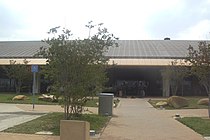Laredo International Airport
Laredo International Airport | |||||||||||||||||||
|---|---|---|---|---|---|---|---|---|---|---|---|---|---|---|---|---|---|---|---|
 USGS aerial image, 9 February 2002 | |||||||||||||||||||
| Summary | |||||||||||||||||||
| Airport type | Public | ||||||||||||||||||
| Owner | City of Laredo | ||||||||||||||||||
| Serves | Laredo, Texas | ||||||||||||||||||
| Elevation AMSL | 508 ft / 155 m | ||||||||||||||||||
| Coordinates | 27°32′38″N 099°27′42″W / 27.54389°N 99.46167°W | ||||||||||||||||||
| Website | CityOfLaredo.com/... | ||||||||||||||||||
| Runways | |||||||||||||||||||
| |||||||||||||||||||
| Statistics (2007) | |||||||||||||||||||
| |||||||||||||||||||



Laredo International Airport (IATA: LRD, ICAO: KLRD, FAA LID: LRD) is a city-owned public-use airport located three nautical miles (6 km) northeast of the central business district of Laredo, a city in Webb County, Texas, United States.[2]
The airport is served by three commercial airlines. In the twelve months ending December 2010, LRD enplaned 111,000 passengers, a 7 percent increase from the same time period the year before. In 2006, LRD totaled 365 million pounds of cargo, a 3 percent decrease from 2005.[citation needed]
History
The Laredo International Airport was used by the United States Army Air Force during World War II as Laredo Army Airfield, and by the United States Air Force as Laredo Air Force Base during the Cold War as a pilot training base with T-33 Shooting Star and later T-37 Tweet and T-38 Talon aircraft. The military presence ended in December 1973 as part of a nation-wide defense cutback following the end of the Vietnam War
Facilities and aircraft
Laredo International Airport covers an area of 1,796 acres (727 ha) at an elevation of 508 feet (155 m) above mean sea level. It has three runways:[2]
- Runway 14/32: 5,928 x 150 ft (1,807 x 46 m), Surface: Concrete
- Runway 17L/35R: 8,236 x 150 ft (2,510 x 46 m), Surface: Concrete
- Runway 17R/35L: 7,711 x 150 ft (2,350 x 46 m), Surface: Asphalt
For the 12-month period ending September 30, 2007, the airport had 57,698 aircraft operations, an average of 158 per day: 48% general aviation, 28% military, 18% air taxi and 7% scheduled commercial. At that time there were 41 aircraft based at this airport: 37% single-engine, 20% multi-engine, 32% jet and 12% helicopter.[2]
There is one, two-floor terminal at the Laredo International Airport. The bottom floor contains the check-in counters, a gift shop, a restaurant, baggage claim, and US customs. The top floor contains two security lanes and four gates, all with jetways. Free Wi-Fi internet access is available throughout the terminal. Gates 3 and 4 allow direct access to US customs. KLRD sometimes receives a share of diverted flights when severe weather threatens Dallas or Houston.
Airlines and destinations
| Airlines | Destinations |
|---|---|
| Allegiant Air | Las Vegas Seasonal: Orlando-Sanford |
| American Eagle | Dallas/Fort Worth |
| Continental Express operated by ExpressJet Airlines | Houston-Intercontinental |
Air cargo operators & destinations
- ABX Air (Wilmington, OH)
- FedEx Express (Memphis, TN)
- UPS Airlines (Louisville, KY)
Accidents and incidents
- On 31 October 1983, Douglas DC-3C N44896 of FBN Flying Service was destroyed by fire at Laredo International Airport while attempting to take-off on a cargo flight to McAllen-Miller International Airport, Texas.[3] A fire had developed on board the aircraft during the take-off run, and the crew were unable to extinguish it with the equipment available to them.[4]
- On 28 July 1987, Douglas C-53 N39DT of La Mesa Leasing Inc was damaged beyond economic repair when the port engine failed shortly after take-off on an international cargo flight to Ciudad Camargo Airport, Mexico. The aircraft was overloaded by 3,809 pounds (1,728 kg) and the power from the remaining good engine was insufficient to sustain flight. The aircraft stalled and crashed whilst attempting to make an emergency landing back at Laredo. Both crew survived.[5] A post-accident investigation revealed no problems with the failed engine.[6]
- On 18 January 1989, Douglas DC-3 XB-DYP crashed shortly after take-off. The aircraft was on an international cargo flight to Torreón International Airport, Mexico. The cause of the accident was that the cargo was improperly secured and shifted in flight, causing the centre of gravity to move aft.[7]
- On 21 May 2002, Douglas DC-3A XB-JBR of Aero JBR ditched in Lake Casa Blanca, Texas after a double engine failure while performing a touch-and-go at Laredo International Airport.[8] It is reported that one of the engines suffered a propellor overspeed condition. All three crew escaped from the submerged aircraft.[9]
- On 9 November 2010, ZA002, a flight test Boeing 787 made an emergency landing after fire had broken out in its P100 electrical panel. [10]
References
- ^ Laredo International Airport, official site
- ^ a b c d FAA Airport Form 5010 for LRD PDF, effective 2008-06-05
- ^ "N44896 Accident report". Aviation Safety Network. Retrieved 27 July 2010.
- ^ "NTSB Identification: FTW84FA038". National Transportation Safety Board. Retrieved 27 July 2010.
- ^ "N39DT Accident description". Aviation Safety Network. Retrieved 27 July 2010.
- ^ "NTSB Identification: FTW87LA180". National Transportation Safety Board. Retrieved 27 July 2010.
- ^ "XB-DYP Accident description". Aviation Safety Network. Retrieved 27 July 2010.
- ^ "XB-JBR Accident description". Aviation Safety Network. Retrieved 21 June 2010.
- ^ Garcia, Robert. "3 survive ditching Engine failure lands plane in Lake Casa Blanca". The DC3 Aviation Museum. Retrieved 21 June 2010.
- ^ flightgobal.com Fire on 787 Test Aircraft
External links
- FAA Airport Diagram (PDF), effective July 11, 2024
- FAA Terminal Procedures for LRD, effective July 11, 2024
- Resources for this airport:
- AirNav airport information for KLRD
- ASN accident history for LRD
- FlightAware airport information and live flight tracker
- NOAA/NWS weather observations: current, past three days
- SkyVector aeronautical chart for KLRD
- FAA current LRD delay information

